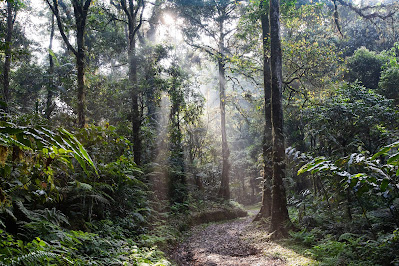- Get link
- X
- Other Apps
- Get link
- X
- Other Apps
According to National Geographic:
"A rain forest is simply an area of tall, mostly evergreen trees and a high amount of rainfall"
However, this is quite some simplification. For instance, London, which has around half a metre of rain per year is very lush, but Sydney, which has nearly double this, can be very dry at times. So, what is the difference?
It's Not What You Do, It's How You Use It!
London, has a much colder climate than Sydney. This affects a variable called evaporation rate. A colder climate you see, will be able to put it's rainfall totals to better use, since less of it will evaporate.
This means that your rain goes a lot further. But how does this affect rainforests?
Generally, it is better to say that a true rainforest is not simply a region of high rainfall, as National Geographic puts it. Instead, it would be better to say that a rainforest exists in an area where total rainfall approaches, or exceeds, the evaporation rate. For instance, although the Poles are not exactly rainforests, in fact they have very little vegetation, they are covered in water, be it ice or liquid. This is because the evaporation is so low in those frigid climes, that even a little precipitation is sufficient to exceed what escapes back into the atmosphere. But how does the arctic affect rainforests?
Rainforests have somewhat of the same principle, it's just that rainfall, and evaporation rates are much higher. Rainforests may have 2 metres(2000mm) of rain per year, and the evaporation may be around the same figure. This means that the ground will generally be moist enough for seeds to germinate, and for plants and trees to grow, without the constraints that droughts, dry monsoons, or mediterranean climates engender.
So, rather than say that a rainforest is an area of high rainfall, it is better to say that a rainforest has sufficient precipitation at any time to allow plant growth to continue unhindered.
What Percentage Of The World Is Rainforest?
When we say Rainforest, we often evoke thoughts of jungles. However, tropical jungles are less common generally, than temperate rainforests. The reason is that again, because the evaporation is so high in these regions, rainfall must be equally voluminous, which of course, is not easy to achieve.
There are tropical rainforests, or jungles..think the Amazon, or the Daintree. However, with the Daintree, it forms part of Australia's rainforests that make up less than 1% of the area of Australia. The Amazon is also shrinking rapidly due to human exploitation.
When it comes to temperate rainforests, not only do they require less rainfall, but they are often the result of prevailing weather systems that are regular in frequency.
Anyone, for instance, who lives in London, will know that Atlantic low pressure rain systems come all too regularly. They are an extension of a weather system that encircles the globe. And, whilst there can be interruptions, the rainfall is generally reliable.
Tropical rainforests rely on diurnal rain storms, and monsoons. The monsoon, for example, can be fairly regular. However, it can also be affected strongly by issues such as deforestation. As an example, the Sahara desert is rumoured to expand it's borders by a mile a year. The reason? Deforestation removes topsoil, preventing plants from growing. The drier air resulting from less vegetation is insufficient to drive the tropical weather systems necessary to produce rainfall.
So, with all of these factors influencing the ability of rainforests to grow, it is no wonder that rainforests are by far, a very small percentage of the occupants of the Earth's landmass.
Australia
Daintree Rainforest
monsoon
Queensland
Sahara Desert
temperate rainforests
tropical rainforests
water cycle
- Get link
- X
- Other Apps


Comments
Post a Comment